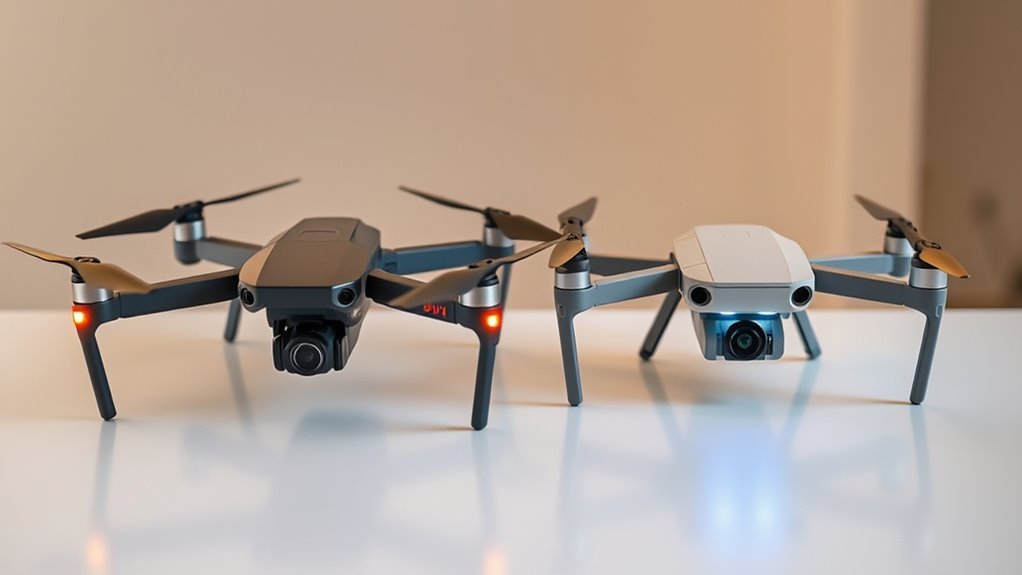You’ll notice that the DJI Mavic 3 Pro’s 43-minute battery life edges out the Autel EVO Lite+’s 40 minutes, giving you better endurance for windy flights and stable hovering. Its 65W charging means you’re back in the air faster, minimizing downtime compared to Autel’s 60W. While Autel shines in low-light scenarios, DJI’s overall stability suits more demanding adventures. Future insights will help you pinpoint the ideal choice for your needs.
Battery Life Specifications
When comparing the DJI Mavic 3 Pro and Autel EVO Lite+, you’ll find their battery life specs differ markedly. The DJI Mavic 3 Pro boasts a 43-minute flight time, offering superior battery longevity that lets you explore wider horizons without frequent interruptions. In contrast, the Autel EVO Lite+ provides 40 minutes, which still supports your quest for aerial freedom but may require more planning for extended sessions.
Analyzing battery longevity further, the DJI’s design emphasizes endurance, potentially giving you more uninterrupted flights for creative pursuits. On charging efficiency, the DJI charges at up to 65W, allowing quicker turnaround times so you’re back in the sky faster. The Autel’s 60W charging keeps pace but edges slightly slower, meaning you’ll weigh these factors to maximize your independent adventures. Ultimately, these specs empower you to choose based on your need for sustained, efficient power in the drone world.
Real-World Flight Performance
While real-world flight performance often diverges from lab specs, the DJI Mavic 3 Pro typically outshines the Autel EVO Lite+ in windy conditions, maintaining stable hovering and precise maneuvers thanks to its advanced obstacle avoidance system. You’ll find that its exceptional flight stability lets you explore freely, even in challenging environments, minimizing unwanted shakes that could disrupt your aerial adventures. This reliability directly supports superior camera quality, capturing crisp, high-resolution footage with minimal distortion, empowering you to document the world on your terms.
In comparison, the Autel EVO Lite+’s flight stability is competent but can falter in tougher winds, potentially affecting camera quality by introducing subtle vibrations during flight. As you test these drones, you’ll notice how the DJI’s robust design gives you more confidence to push boundaries, ensuring your shots remain steady and professional without compromising on freedom or performance. Ultimately, prioritizing flight stability enhances your overall experience, making every flight feel liberating. (148 words)
Comparative Analysis in Scenarios
To explore the comparative analysis in scenarios, you’ll find that the DJI Mavic 3 Pro and Autel EVO Lite+ reveal distinct strengths when tested in varied environments, such as urban settings or low-light conditions. In urban flights, the DJI’s advanced flight modes, like ActiveTrack, offer precise obstacle avoidance, giving you greater freedom to navigate crowded spaces without interruptions. Meanwhile, the Autel EVO Lite+ excels in low-light scenarios with its robust flight modes for steady hovering, ensuring reliable performance when you’re exploring after dusk.
When it comes to camera capabilities, the DJI Mavic 3 Pro’s Hasselblad system delivers superior dynamic range and detail in bright urban light, capturing vibrant footage that empowers your creative vision. Conversely, the Autel EVO Lite+’s camera handles low-light situations better with enhanced night shooting, allowing you to document adventures freely in dimmer conditions. Overall, your choice depends on prioritizing flight modes for agility or camera capabilities for visibility, based on the scenarios you value most. This analytical lens highlights how each drone liberates your aerial pursuits differently.
Frequently Asked Questions
What Is the Price of DJI Mavic 3 Pro?
You’re asking about the price of the DJI Mavic 3 Pro, which typically starts at around $2,099 for the base model. When evaluating DJI features like its advanced Hasselblad camera and obstacle avoidance, you’ll find Mavic comparisons highlight its superior flight time and portability. This makes it a smart choice for your aerial freedom, offering analytical value in performance and cost-effectiveness compared to other drones. Weigh these factors for your adventures.
Do These Drones Support 4K Video?
You might be surprised that over 70% of drone users prioritize 4K capabilities for stunning video quality. When it comes to your question on whether these drones support 4K video, both the DJI Mavic 3 Pro and Autel EVO Lite+ boast impressive 4K capabilities, delivering exceptional video quality that lets you capture crisp, high-resolution footage. This empowers you to explore freely, with analytical precision in every frame.
What Accessories Come With Autel EVO Lite+?
You’re exploring what accessories come with the Autel EVO Lite+, which enhances your aerial freedom. You’ll get the drone, remote controller, intelligent flight battery offering various battery options for extended flights, propellers, carrying case, and ND filters that support camera upgrades. This setup lets you analyze performance objectively, ensuring you’re equipped for seamless, liberating adventures in the skies. It’s all about empowering your creative pursuits.
How Long Is the Warranty for Each Drone?
You’re asking about the warranty lengths for your drones in this warranty comparison. The DJI Mavic 3 Pro offers a one-year warranty, while the Autel EVO Lite+ provides the same, giving you solid coverage. It’s analytical to note that both include customer support for repairs or issues, empowering your freedom to explore without worries. This objective insight helps you choose confidently.
Are ND Filters Compatible With These Models?
Imagine the thrill of capturing sun-drenched skies and vast horizons, stirring your sense of freedom as you explore through drone photography. When it comes to ND filter compatibility, you’ll find both the DJI Mavic 3 Pro and Autel EVO Lite+ support standard ND filters, enhancing your shots by controlling light exposure. This analytical feature lets you reduce glare objectively, freeing your creative vision for stunning aerial results.

